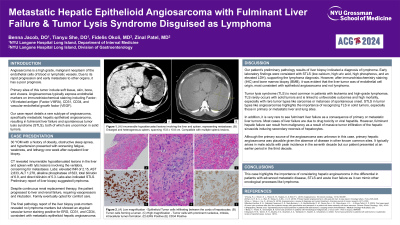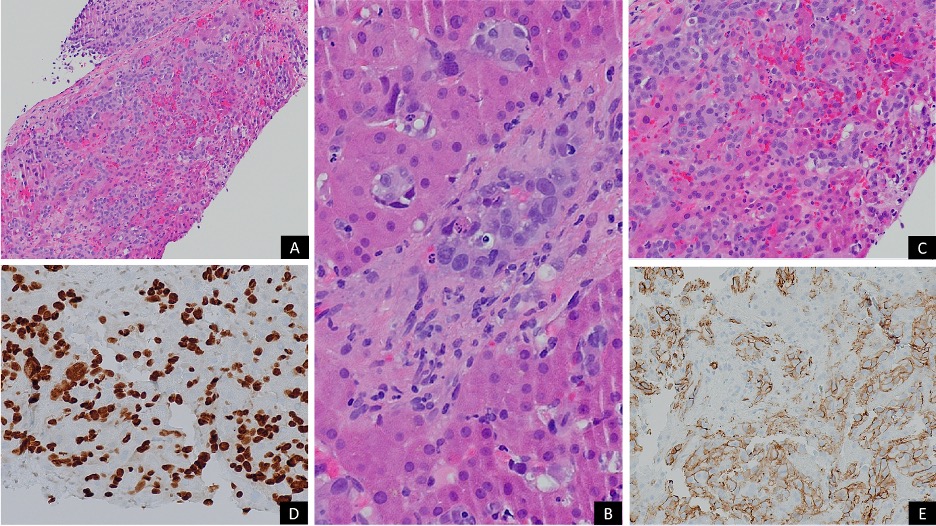Monday Poster Session
Category: Liver
P3061 - Metastatic Hepatic Epithelioid Angiosarcoma With Fulminant Liver Failure and Tumor Lysis Syndrome Disguised as Lymphoma
Monday, October 28, 2024
10:30 AM - 4:00 PM ET
Location: Exhibit Hall E

Has Audio

Benna Jacob, DO
NYU Langone Health
Mineola, NY
Presenting Author(s)
Benna Jacob, DO1, Tianyu She, DO2, Fidelis Okoli, MD1, Syed Hoda, MD1, Zinal Patel, MD1
1NYU Langone Health, Mineola, NY; 2New York University Langone Health Long Island, Mineola, NY
Introduction: Angiosarcoma is a high grade, malignant neoplasm of the endothelial cells of blood or lymphatic vessels. Due to its rapid progression and early metastasis to other organs, it has a poor prognosis. This case details a rare subtype of angiosarcoma, specifically metastatic hepatic epithelioid angiosarcoma, resulting in fulminant liver failure and tumor lysis syndrome.
Case Description/Methods: 30-year-old male with a history of obesity, obstructive sleep apnea, and hypertension presented with worsening fatigue, weakness, and lethargy one week after outpatient liver biopsy. Initial CT revealed innumerable hypoattenuated lesions in the liver and spleen with lytic lesions involving the vertebra, concerning for metasteses. His labs noted an elevated INR of 2.15, AST 2,833 IU/L, ALT 1,278 IU/L, alkaline phosphatase of 623 IU/L, total bilirubin of 6.9 mg/dL, and direct bilirubin of 5.3 mg/dL. Labs were also consistent with tumor lysis syndrome (TLS). Preliminary report of the liver biopsy was suggestive of lymphoma. Despite continuous renal replacement therapy, the patient developed liver and renal failure, requiring vasopressor support for persistent hypotension and intubation. His family eventually opted for comfort care. The final pathology report of the liver biopsy post-mortem was negative for lymphoma markers and showed an infiltrative, atypical vascular tumor staining strongly for ERG, CD31, and CD34, consistent with metastatic epithelioid hepatic angiosarcoma.
Discussion: Our patient’s preliminary pathology results of liver biopsy indicated a diagnosis of lymphoma. Early laboratory findings also corroborated tumor lysis syndrome, supporting this diagnosis. However, after immunohistochemistry staining (IHC), it was evident that the liver tumor was most consistent with epithelioid angiosarcoma. Spontaneous tumor lysis syndrome (STLS) is typically noted in hematological malignancies and is uncommon in solid tumors. It is also very rare to see fulminant liver failure as a result of primary or metastatic liver tumors. Most cases of liver failure are due to drug toxicity or viral hepatitis. However, massive tumor infiltration of the hepatic sinusoids inducing secondary necrosis of hepatocytes may have led to fulminant hepatic failure in our patient. This case highlights the importance of considering hepatic angiosarcoma in the differential in patients with advanced metastatic disease, STLS and acute liver failure as it can mimic other oncological processes like lymphoma.

Disclosures:
Benna Jacob, DO1, Tianyu She, DO2, Fidelis Okoli, MD1, Syed Hoda, MD1, Zinal Patel, MD1. P3061 - Metastatic Hepatic Epithelioid Angiosarcoma With Fulminant Liver Failure and Tumor Lysis Syndrome Disguised as Lymphoma, ACG 2024 Annual Scientific Meeting Abstracts. Philadelphia, PA: American College of Gastroenterology.
1NYU Langone Health, Mineola, NY; 2New York University Langone Health Long Island, Mineola, NY
Introduction: Angiosarcoma is a high grade, malignant neoplasm of the endothelial cells of blood or lymphatic vessels. Due to its rapid progression and early metastasis to other organs, it has a poor prognosis. This case details a rare subtype of angiosarcoma, specifically metastatic hepatic epithelioid angiosarcoma, resulting in fulminant liver failure and tumor lysis syndrome.
Case Description/Methods: 30-year-old male with a history of obesity, obstructive sleep apnea, and hypertension presented with worsening fatigue, weakness, and lethargy one week after outpatient liver biopsy. Initial CT revealed innumerable hypoattenuated lesions in the liver and spleen with lytic lesions involving the vertebra, concerning for metasteses. His labs noted an elevated INR of 2.15, AST 2,833 IU/L, ALT 1,278 IU/L, alkaline phosphatase of 623 IU/L, total bilirubin of 6.9 mg/dL, and direct bilirubin of 5.3 mg/dL. Labs were also consistent with tumor lysis syndrome (TLS). Preliminary report of the liver biopsy was suggestive of lymphoma. Despite continuous renal replacement therapy, the patient developed liver and renal failure, requiring vasopressor support for persistent hypotension and intubation. His family eventually opted for comfort care. The final pathology report of the liver biopsy post-mortem was negative for lymphoma markers and showed an infiltrative, atypical vascular tumor staining strongly for ERG, CD31, and CD34, consistent with metastatic epithelioid hepatic angiosarcoma.
Discussion: Our patient’s preliminary pathology results of liver biopsy indicated a diagnosis of lymphoma. Early laboratory findings also corroborated tumor lysis syndrome, supporting this diagnosis. However, after immunohistochemistry staining (IHC), it was evident that the liver tumor was most consistent with epithelioid angiosarcoma. Spontaneous tumor lysis syndrome (STLS) is typically noted in hematological malignancies and is uncommon in solid tumors. It is also very rare to see fulminant liver failure as a result of primary or metastatic liver tumors. Most cases of liver failure are due to drug toxicity or viral hepatitis. However, massive tumor infiltration of the hepatic sinusoids inducing secondary necrosis of hepatocytes may have led to fulminant hepatic failure in our patient. This case highlights the importance of considering hepatic angiosarcoma in the differential in patients with advanced metastatic disease, STLS and acute liver failure as it can mimic other oncological processes like lymphoma.

Figure: Figure 3. (A) Low magnification - Epithelioid Tumor cells infiltrating between the cords of hepatocytes. (B) Tumor cells forming a lumen. (C) High magnification - Tumor cells with prominent nucleolus, mitosis, intracellular lumen formation. (D) ERG Positive (E) CD34 Positive
Disclosures:
Benna Jacob indicated no relevant financial relationships.
Tianyu She indicated no relevant financial relationships.
Fidelis Okoli indicated no relevant financial relationships.
Syed Hoda indicated no relevant financial relationships.
Zinal Patel indicated no relevant financial relationships.
Benna Jacob, DO1, Tianyu She, DO2, Fidelis Okoli, MD1, Syed Hoda, MD1, Zinal Patel, MD1. P3061 - Metastatic Hepatic Epithelioid Angiosarcoma With Fulminant Liver Failure and Tumor Lysis Syndrome Disguised as Lymphoma, ACG 2024 Annual Scientific Meeting Abstracts. Philadelphia, PA: American College of Gastroenterology.
